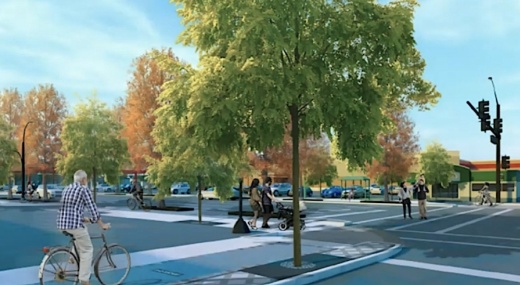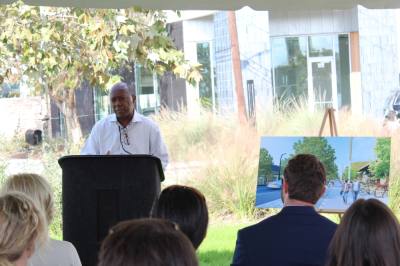The redevelopment project—which spans roughly 5 miles from the northern segment of Loop 610 to I-10 West—will reduce the number of traffic lanes on each road from four to three while adding protected bike lanes and installing sidewalks. The roadways being redeveloped date back to the 1950s, said Anne Lents, chair of the Memorial Heights Redevelopment Authority and the Memorial Heights Tax Increment Reinvestment Zone, which are leading the project.
"People are going to be able to walk and bike along these roads; they are going to be able to get to the businesses that are sprouting up all over more easily," Lents said at the Dec. 4 event. "They are going to connect to our growing hike and bike trail network. We are going to have better flood management. Most importantly, we are going to be able to do all these things in the area more safely than we’ve been able to do in the past."
The $115 million project was fast-tracked with help from a variety of local leaders and elected officials, Lents said, many of whom were present at the Dec. 4 groundbreaking.
U.S. Rep. Dan Crenshaw and U.S. Sen. John Cornyn helped secure a $25 million build grant from the Federal Highway Administration for the first phase of the project from Loop 610 to West 15th Street. The Houston-Galveston Area Council provided an award of $40 million that, matched with $10 million in local matching funds from the TIRZ, will help fund the second phase from West 15th Street and I-10.
Craig Raborn, H-GAC's director of transportation, said projects like the Shepherd-Durham redevelopment can serve as a model for how to create multimodal corridors that serve all users, whether they be cars, bikes or pedestrians.
"This project is a tangible example of how ... the projects that come out of transportation planning are evolving," Raborn said at the Dec. 4 event. "Better no longer needs to mean bigger. It can actually mean better."
The lane reduction is warranted based on current and future traffic volume projections, Houston Public Works Director Carol Haddock said.
In addition to the lane reduction, the project also includes installing new traffic signals, crosswalk striping, new signal timing to reduce congestion and crashes, the repositioning of some bus stops, protected bike lanes, wider sidewalks, more trees, and the replacement of underground water and sewer infrastructure while the road is being redone.
The city also partnered with business owners on access into and out of parking lots, Haddock said. In some cases, driveways will be removed or relocated from Shepherd and Durham to side streets, she said.
More than 1,000 crashes have occurred on the stretches of Shepherd and Durham slated for improvement since the spring of 2019, as well as two deaths, according to a traffic engineering study on the roadways.
Citing that study, Houston Mayor Sylvester Turner said the project will reduce common vehicle crashes by 50%, pedestrian crashes by 67% and bicycle crashes by 38%.
"That is deserving of every single dollar," Turner said.
Construction is expected to begin in January on Phase 1, and construction on Phase 2 could start in 2023. The overall project is expected to be ongoing for 5-6 years.






